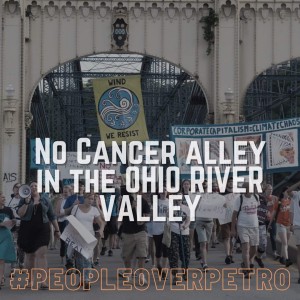.
.
From the Letter of Angie Rosser, Executive Director of the West Virginia Rivers Coalition, Beckley Register-Herald, December 10, 2021
.
.
.
Public Comment on the Environmental Protection Agency notice titled “Meetings: White House Environmental Justice Advisory Council.”
>>>>> —— >>>>>
Whereas the WHEJAC (White House Environmental Justice Advisory Council ) provides advice and recommendations about “issues of environmental justice and pollution reduction, energy, climate change mitigation and resiliency, environmental health, and racial inequality,”1 WV Rivers would like to raise concerns regarding regulatory, community, and economic issues related to environmental justice in West Virginia.
The issues we wish to highlight in our state are environmental sacrifice zones, inequitable energy resources, unsafe drinking water, climate disasters, and natural gas pipelines as symptoms of systemic environmental injustices that can be mitigated through the adoption of science-based and thoughtful policies.
● Environmental sacrifice zones: Approximately 96,000 people live in an area of industrial cancer risk around Charleston, West Virginia, where the highest estimated excess lifetime cancer risk from industrial sources is 36 times the EPA’s acceptable risk due to emissions from nearby facilities. These environmental sacrifice zones disproportionately affect low-income communities and communities of color. Notably, the toxic hot spot with the highest risk in West Virginia (1 in 280) has a high concentration of Black people and hosts the historically Black college, West Virginia State University.2
In communities near mountaintop removal coal mining, residents living in proximity to surface mines face higher rates of death from cancer, respiratory diseases, and cardiovascular diseases.3
West Virginia has the highest risk of toxic exposure to selenium leaching into waterways from coal mining and industrial pollution in the country.4
Drinking and waste water infrastructure in low-income communities once centered around and now bankrupt coal companies, also face disproportionate neglect leading to multi-year boil water notices and water service disruptions.5, 6
The air and water pollution from coal produces direct health and ecosystem impacts, and remnants of the 20th century “company town” concept further leads to shortened life expectancies and outmigration in these communities.7
With the second-lowest median household income among all 50 states, many West Virginian communities qualify as disadvantaged federally. Furthermore, a 150 percent increase in average monthly residential electric bills for American Electric Power customers over the past 15 years has made energy less accessible to residents.8
Whereas, the Justice40 initiative committed to directing “40 percent of the overall benefits” from federal environmental and energy investments to disadvantaged communities;9 it is vital that the WHEJAC provide recommendations to address pollutive harm imposed on communities located in West Virginia’s sacrifice zones in the “chemical valley.”
● Climate disasters: In West Virginia, climate change often expresses itself through water, specifically floods. West Virginia has one of the highest flood risks in the country, according to a recent report10 by First Street Foundation with nearly one in four properties in the state found to be at high risk of flooding. Moreover, greater than one in 10 West Virginia properties are at almost certain risk of flooding over the next 30 years. Dunbar, notably located between two toxic hot spots discussed previously in “environmental sacrifice zones,” has an extreme risk of flooding; this is the greatest risk level in the state with approximately 80 percent of residential properties at high risk.11
Historically, floods have devastated parts of the state. In 2016 and 1985, floods destroyed properties and businesses and killed 23 and 63 people, respectively.12
Climate adaptation measures must center environmental justice through sufficient investments in communities vulnerable to climate disasters, like flooding.
● Natural gas pipelines: The completion of the Mountain Valley Pipeline (MVP) will directly harm communities along its route and affect all West Virginians by damaging our mountains and water resources. The issuance of a permit for the completion of the MVP would be contrary to the public interest and devastate the surrounding environment. Some concerning impacts of this pipeline are harm to endangered species habitats, degradation to water quality, and contribution to the effects of climate change that disproportionately impact underserved and minority populations. Specifically “low-income communities, elderly residents and Indigenous sites” are at greatest risk along the proposed 303 mile pipeline.13
This project will permanently alter the soils and hydrology of approximately 10 acres of wetlands which are vital for habitat, flooding reduction and improving water quality. As a result, it creates flooding hazards with increased scouring of the unconsolidated material in the stream bed potentially exposing the pipe during high flows. In addition to numerous private wells and springs along the route, the MVP has the potential to impact drinking water supplies of 8 public water utilities. Already, the development has degraded water quality with only a small fraction of the waterbody crossings completed. The Virginia Department of Environmental Quality and the West Virginia Department of Environmental Protection cited the MVP approximately 300 times for violating water quality standards. Ultimately the pipeline will contribute significant amounts of methane to the atmosphere accelerating the impacts of climate change.14
● SUMMARY — Environmental injustice in West Virginia can be viewed as cyclical. Direct harm imposed by pollutive and extractive industries through air pollution or water contamination in sacrifice zones creates long-term health and ecological consequences, often for vulnerable populations. Emissions produced by these industries further contribute to global warming and exacerbate more frequent and intense climate disasters. As the WHEJAC considers draft recommendations to the Chair of the Council on Environmental Quality and the White House Interagency Council on Environmental Justice from the Justice40 Work Group, Climate and Economic Justice Screening Tool Work Group, and the Scorecard Work Group, we urge members of the council to consider West Virginia communities in the discussion.
Footnotes: See the Comment(s) Below …


{ 1 comment… read it below or add one }
Footnotes:
1/ https://www.regulations.gov/document/EPA-HQ-OA-2021-0683-0001
2/ https://projects.propublica.org/toxmap/
3/ https://appvoices.org/end-mountaintop-removal/health-impacts/
4/ https://www.wvgazettemail.com/news/energy_and_environment/west-virginia-under-toxic-threat-from-hig hest-industrial-selenium-pollution-levels-in-the-country/article_5a99d49c-3362-5273-87ab-c6235827a164.html
5/ https://www.wvpublic.org/news/2020-03-02/clean-water-wanted-contaminated-wells-and-the-legacy-of-fossil-fuel-extraction
6/ https://www.wvpublic.org/news/2017-02-17/drinking-water-from-an-abandoned-mine-really
7/ https://marshallcop26.files.wordpress.com/2021/10/just_energy_transtions_long.pdf
8/ https://www.wvgazettemail.com/news/energy_and_environment/wv-advocates-urge-state-leaders-to-capi talize-on-federal-environmental-justice-push-by-embracing-clean/article_42153091-6bd6-56d3-b5a2-6bd8 ef8594e6.html
9/ https://www.whitehouse.gov/wp-content/uploads/2021/07/M-21-28.pdf
10/ https://assets.firststreet.org/uploads/2021/09/The-3rd-National-Risk-Assessment-Infrastructure-on-the-B rink.pdf
11/ https://floodfactor.com/city/dunbar-westvirginia/5422564_fsid
12/ https://www.ncdc.noaa.gov/billions/
13/ https://appvoices.org/fracking/mountain-valley-pipeline/
14/ https://wvrivers.org/wp-content/uploads/2021/10/ACOE-MVP-Public-Hearing-Factsheet.pdf